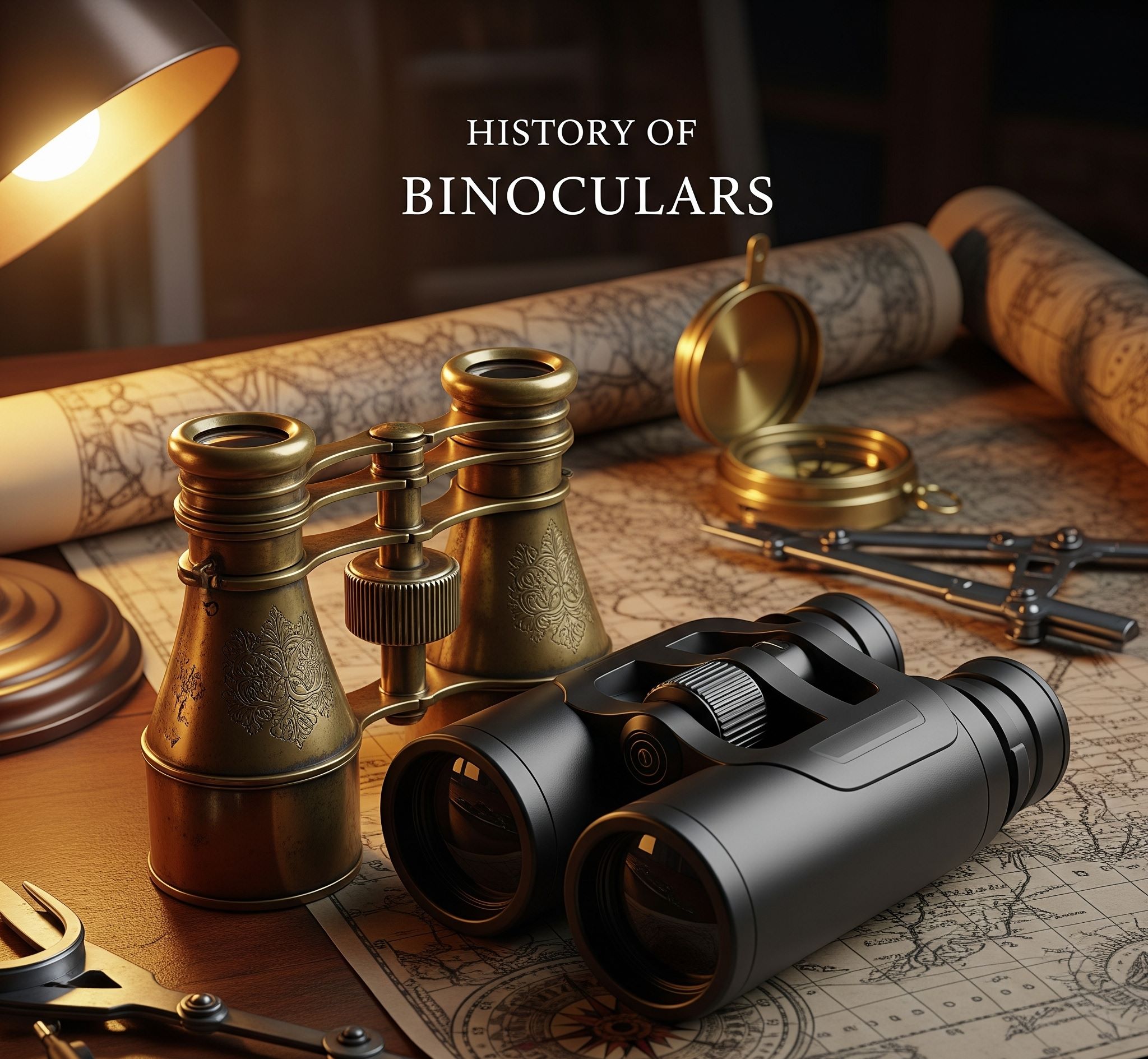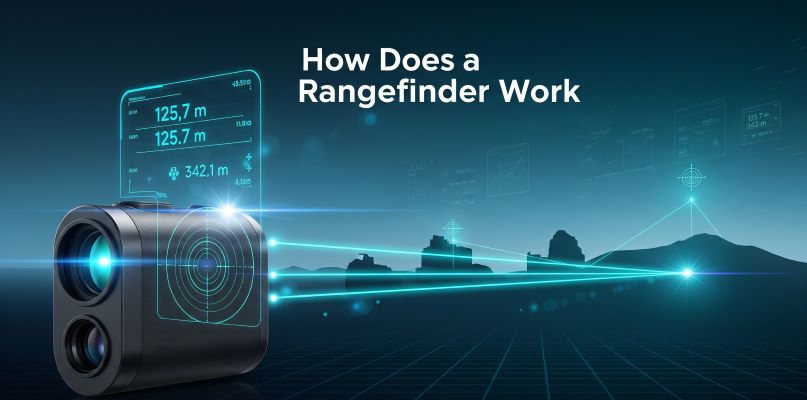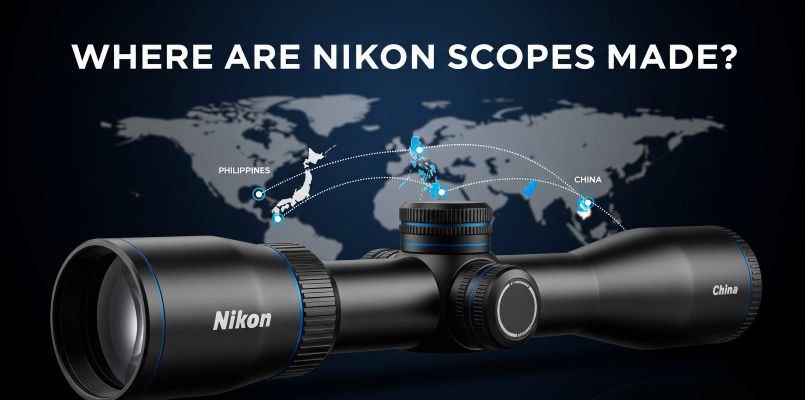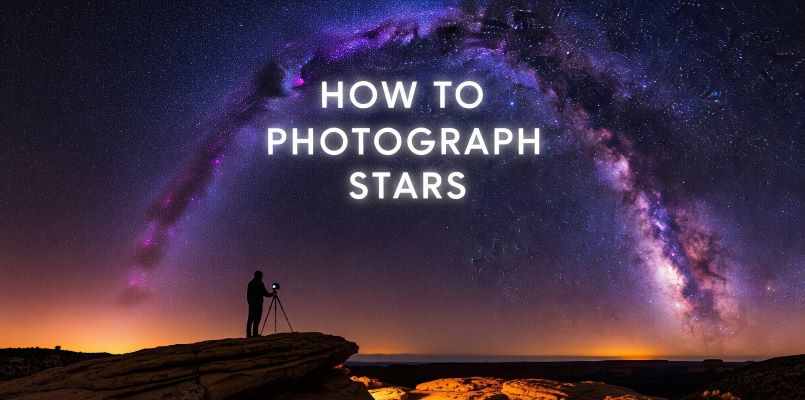

The fascinating journey of binoculars spans over 400 years, evolving from simple magnifying lenses to sophisticated optical instruments that bring distant worlds closer to our eyes. A complete history of binoculars reveals a story of innovation, scientific breakthroughs, and the human desire to see beyond our natural limitations. From ancient Egyptian glass experiments to today’s digital binoculars, this comprehensive guide explores when binoculars came about, the development of crucial technologies like prism systems, and the evolution that gave us modern optical marvels.
The history of binocular lens development begins not with binoculars themselves, but with humanity’s earliest experiments with glass and optics. Archaeological evidence shows that ancient civilizations, particularly the Egyptians of the 4th dynasty (around 2613-2494 BCE), created polished crystal lenses from quartz. These weren’t used for magnification as we understand it today, but rather as decorative objects and possibly as burning glasses to focus sunlight.
The Romans advanced optical understanding significantly around the 1st century AD. They developed what they called “burning glasses” – simple magnifying devices made from glass spheres filled with water. These rudimentary tools laid the groundwork for all future optical instruments, though it would take more than a millennium before these concepts evolved into practical viewing devices.
The real breakthrough in optical science came during the 13th century in Italy. Roger Bacon, a Franciscan friar, made a revolutionary suggestion in 1267: placing sheets of glass over text could assist in reading. This simple observation sparked a revolution in optics. By the end of the 13th century, Italian craftsmen were mounting these magnifying lenses into frames, creating the first corrective eyeglasses. These early spectacles used convex lenses to treat hyperopia (farsightedness), marking the birth of practical optics.
The path to binoculars truly began in the early 17th century with the invention of the telescope. In October 1608, Hans Lippershey, a Dutch spectacle maker from Middelburg, submitted the first patent application for what he called “a certain device by means of which all things at a very great distance can be seen as if they were nearby.” His design combined a convex objective lens with a concave eyepiece, creating magnification of about 3-4 times.
Galileo Galilei heard of this Dutch invention and, without ever seeing one, constructed his own improved version in 1609. Galileo’s telescopes achieved magnifications of up to 20x initially, and later 30x. Despite the blurry and unclear images these early telescopes produced, Galileo used them to make groundbreaking astronomical discoveries, including observing craters on the Moon and discovering the four largest moons of Jupiter.
Johannes Kepler proposed a significant improvement to telescope design by suggesting the use of two convex lenses instead of Galileo’s convex-concave combination. This “Keplerian” design produced clearer images with greater magnification, though it had one major drawback: the image appeared inverted. This limitation would drive future innovations in optical design.
One of the most important binoculars history facts is the precise date when binoculars were born. When Hans Lippershey demonstrated his telescope to the States-General of the Netherlands, the officials were impressed but made an unusual request: could he create a version that allowed viewing with both eyes?
Lippershey accepted the challenge and on December 8, 1608, he presented the world’s first binoculars – essentially two telescopes mounted side by side. The States-General requested that he produce additional units using quartz crystal optics rather than glass, believing the crystal would provide superior clarity given the poor quality of optical glass available at the time.
These first binoculars had significant limitations. With only 3-4x magnification and poor image quality, they weren’t practical for widespread use. The quartz crystal versions Lippershey produced were particularly challenging to manufacture, and despite completing the requested instruments, he was ultimately denied his patent as other inventors claimed similar devices.
Following Lippershey’s invention, binoculars entered a curious period of stagnation while telescopes continued to advance rapidly. For over 200 years, binoculars remained essentially unchanged – crude instruments that were difficult to use and produced poor images. Several factors contributed to this lag:
The first successful commercial binoculars didn’t appear until 1823, when Johann Friedrich Voigtländer of Vienna produced the first handheld binocular telescopes. These “opera glasses” used Galilean optics and were compact enough for theater use, though they offered only 2-4x magnification.
The modern era of binoculars began in 1854 when Italian optician Ignazio Porro patented his revolutionary prism erecting system. Porro’s genius was recognizing that prisms could fold the light path within binoculars while simultaneously correcting image orientation. His design used two right-angled prisms in each barrel, arranged in a Z-shaped configuration.
Porro prisms offered multiple advantages that transformed binocular design:
Despite Porro’s innovation, early prism binoculars struggled commercially. The optical glass available in the 1850s-1870s was still of poor quality, and manufacturing techniques couldn’t produce prisms with the necessary precision. Many early manufacturers attempted to produce Porro prism binoculars but failed due to these technical limitations.
The transformation of binoculars from curiosity to practical instrument came through the collaboration of three German innovators: Carl Zeiss, Ernst Abbe, and Otto Schott. Carl Zeiss founded his optical workshop in Jena in 1846, initially producing microscopes. When he partnered with physicist Ernst Abbe in 1866, they began applying scientific principles to optical design rather than relying on trial and error.
The breakthrough came in 1886 when Otto Schott developed new types of optical glass with unprecedented clarity and consistency. This borosilicate “crown glass” eliminated many of the bubbles and impurities that plagued earlier optics. In 1893, Abbe presented a prism telescope design at the Vienna Trade Fair that combined Porro’s prism concept with Schott’s superior glass.
In 1894, Zeiss introduced the first commercially successful prism binoculars. These instruments offered 6x and 8x magnification with clear, bright images that far surpassed anything previously available. The success was immediate and transformative – within a few years, Zeiss binoculars were being used by militaries, scientists, and outdoor enthusiasts worldwide.
The 10x binoculars history represents a fascinating chapter in optical development. While early binoculars typically offered 3-6x magnification, users constantly desired more powerful instruments. However, increasing magnification brought significant challenges.
In the early 1900s, manufacturers began experimenting with higher magnifications. The development of 10x binoculars required solving several technical problems:
By the 1920s, advances in lens coating technology made 10x binoculars practical. Carl Zeiss employee Alexander Smakula invented anti-reflective coating in 1935, which increased light transmission by 50%. This breakthrough allowed 10x binoculars to deliver bright, clear images despite the higher magnification.
Today, 10x magnification remains one of the most popular choices, offering what many consider the perfect balance between magnification and usability. Modern 10×42 and 10×50 binoculars provide excellent detail while remaining steady enough for handheld use, making them ideal for birdwatching, hunting, and general nature observation.
While Porro prisms dominated binocular design for decades, a new configuration emerged in the 1870s. Achille Victor Emile Daubresse developed the first roof prism design around 1870, though these early models weren’t commercially viable. The concept gained traction when Moritz Hensoldt began marketing roof prism binoculars in 1897.
Two main roof prism designs emerged:
Roof prism binoculars offered a more streamlined design with objective lenses in line with the eyepieces, making them more compact and easier to handle. However, they required extremely precise manufacturing tolerances and special phase-correction coatings to match the performance of Porro prism designs.
The 20th century brought rapid advancement in binocular technology. Each decade introduced innovations that improved performance and usability:
The invention of anti-reflective lens coatings revolutionized binocular performance. These thin layers of magnesium fluoride reduced light reflection from 5% to 1% per surface, dramatically improving image brightness and contrast. During World War II, coated optics gave Allied forces a significant advantage in low-light conditions.
The introduction of aluminum and later polymer housings replaced heavy brass construction, making binoculars more portable. In 1954, Zeiss introduced telescopic eyepieces that allowed for more compact designs. The iconic Zeiss 8×20 pocket binoculars, introduced in 1969, could fold small enough to fit in a shirt pocket while still delivering excellent optical performance.
The development of nitrogen-purged, waterproof binoculars in the early 1970s made quality optics available for marine and extreme weather use. O-ring seals and nitrogen filling prevented internal fogging and protected against moisture damage. By the 1980s, rubber armor coatings provided shock protection and improved grip.
The introduction of phase-correction coatings for roof prisms in the 1990s finally allowed them to match Porro prism performance. Zeiss introduced their P-coating (phase-correcting coating) that eliminated the interference effects that had limited roof prism designs. This advancement made high-quality compact binoculars possible.
The 21st century has brought binoculars into the digital age with innovations that would have seemed like science fiction to Hans Lippershey:
First introduced by Zeiss in 1990 with their 20×60 S model, image stabilization technology uses gyroscopes and movable prisms to compensate for hand shake. Modern stabilized binoculars allow steady viewing at magnifications up to 20x without a tripod.
Digital binoculars incorporate cameras, allowing users to capture photos and videos of what they observe. Some models include GPS, digital compasses, and rangefinders, turning binoculars into multi-function observation tools. Wi-Fi connectivity enables instant sharing of observations.
Modern binoculars feature complex multi-layer coatings that can include:
The integration of night vision and thermal imaging technology has extended binocular use into complete darkness. These electronic enhancements allow for wildlife observation, search and rescue operations, and security applications in conditions where traditional optics would be useless.
The rich history of binoculars has spawned a dedicated community of collectors and historians. The binocular history society isn’t a single organization but rather a global network of enthusiasts who preserve and study vintage optical instruments. Notable groups include:
Collecting vintage binoculars has become increasingly popular, with rare models commanding high prices. Particularly sought-after pieces include:
These collectors serve as important historians, preserving not just the instruments but the knowledge of how they were made and used. Many vintage binoculars from the early 20th century still function perfectly, a testament to their exceptional build quality.
As binoculars evolved, a standardized system for describing their capabilities emerged. Understanding these specifications helps appreciate how far optical technology has advanced:
From Lippershey’s 3x binoculars to modern 25x stabilized models, magnification capabilities have increased dramatically. However, the most popular magnifications (7x, 8x, and 10x) have remained consistent since the early 1900s, proving that higher magnification isn’t always better.
Early binoculars typically had small 20-30mm objectives. Modern binoculars range from compact 20mm models to giant 100mm astronomical binoculars. The sweet spot for general use has settled around 42-50mm, balancing light gathering with portability.
Advances in eyepiece design have dramatically increased fields of view. Early binoculars might offer 3-4 degrees, while modern wide-angle designs can exceed 8 degrees at the same magnification, making it easier to locate and track subjects.
Different regions developed distinctive binocular manufacturing traditions that shaped the industry:
Germany, particularly the Jena region, became synonymous with optical excellence. Companies like Zeiss, Leitz, and Hensoldt set standards for optical quality that remain benchmarks today. German manufacturers pioneered most major optical innovations, from lens coatings to roof prism designs.
Post-WWII Japan emerged as a major force in optics. Companies like Nikon, Canon, and Fujinon combined German optical principles with innovative manufacturing techniques, making quality binoculars more affordable. Japanese manufacturers introduced many electronic features and excel at high-quality roof prism designs.
American manufacturers like Bausch & Lomb focused on practical, durable designs for military and civilian use. They pioneered rubber armoring and developed specialized binoculars for specific applications like marine use.
The Soviet Union produced distinctive binoculars optimized for military use, including unique wide-angle designs and specialized models for tank commanders and naval use. These robust instruments have become popular with collectors.
As we look toward the future, several emerging technologies promise to further transform binoculars:
AR integration could overlay digital information onto the optical view, providing real-time data about observed objects, from bird species identification to stellar coordinates.
AI-powered binoculars could automatically identify and track subjects, adjust settings for optimal viewing, and even suggest points of interest based on location and user preferences.
Graphene and other nanomaterials could enable ultra-thin, ultra-strong lens coatings with unprecedented optical properties. Carbon fiber and advanced polymers continue to reduce weight while increasing durability.
Technology borrowed from astronomy could allow binoculars to compensate for atmospheric distortion in real-time, providing sharper views at high magnifications.
The complete history of binoculars teaches valuable lessons for modern users. Despite all technological advances, the fundamental purpose remains unchanged: bringing distant objects closer while maintaining a natural viewing experience. When choosing binoculars in 2025, consider these historical insights:
As binocular technology advances, preserving its history becomes increasingly important. Museums worldwide maintain collections of historic binoculars, but private collectors play an equally vital role. They maintain, document, and share knowledge about vintage instruments that might otherwise be lost.
Several organizations work to preserve binocular heritage:
From Hans Lippershey’s crude first binoculars in 1608 to today’s digitally enhanced instruments, a complete history of binoculars reveals humanity’s persistent desire to extend our vision. Each innovation, from Porro’s prisms to modern image stabilization, has built upon previous discoveries to create instruments that would seem magical to early users.
The development of binoculars mirrors broader technological progress: initial innovation, gradual refinement, revolutionary breakthroughs, and continuous improvement. Today’s binoculars incorporate centuries of optical knowledge, materials science, and manufacturing expertise into instruments that anyone can use to explore the world around them.
As we continue into the 21st century, binoculars remain relevant despite competition from digital cameras and smartphones. The immediacy of optical viewing, the three-dimensional perspective, and the connection to a rich historical tradition ensure that binoculars will continue evolving to meet new challenges and opportunities. Whether you’re a collector preserving vintage instruments, a birder using the latest ED glass binoculars, or someone discovering the joy of magnified vision for the first time, you’re part of a story that began over 400 years ago and continues to unfold with each new innovation.



